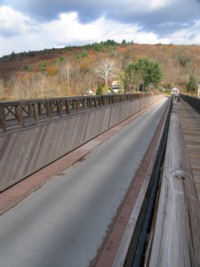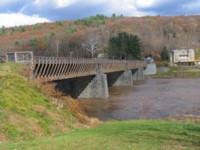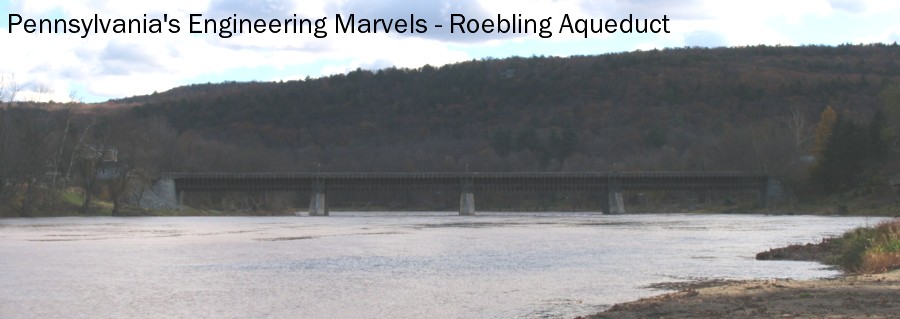In a quiet and
often overlooked corner of Northeastern Pennsylvania, the country's oldest
surviving suspension bridge crosses the Delaware River into New York.
The Delaware Aqueduct, designed and built by famed engineer John A. Roebling,
has withstood a very colorful history from being an important piece in
the region's transportation, to uncertainty during the growth of rail,
nearly eight decades of neglect and poor management as a private toll bridge,
to finally being restored by the National Park Service and in use as an
automobile bridge today.

Construction and
Canal Era (1847-1898):
During the 1840's, the Delaware &
Hudson Canal was looking at ways to speed up service along its route.
One of the major bottlenecks was where the canal reached the Delaware River.
Since it began operation in 1828, the D&H used a rope ferry to pull
traffic along to Canal across the Delaware. The conflicting traffic
of vessels going down the Delaware to Trenton or Philadelphia and of the
coal freight cutting across the river on the canal created great bottlenecks.
That is in addition to the difficulty ferry operators would have fighting
the powerful current.
In 1847, the D&H commissioned
John A. Roebling to construct a suspension bridge that would carry canal
traffic above the Delaware. In comparison to then-contemporary designs,
Roebling's suspension design allowed for more room for downriver traffic
and the dangerous ice floes to pass through. Two years later
on April 26, 1849 at a cost of $41,750, Roebling's Delaware Aqueduct
opened to canal traffic. Soon thereafter, a sister suspension aqueduct,
the Lackawaxen, was opened nearby at a cost of $18,650. (1) The two
bridges' impact were immediate and impressive as canal traffic was shortened
by one full day. The D&H was so impressed by the success and
the bottom-line impact of the two bridges that they commissioned Roebling
to design and construct another two. Two years later, Roebling finished
the construction of the Neversink and High Falls Aqueducts in New York.
Eight Decades of
Neglect (1901-1980):
As railroads grew throughout the
country, the need for canal traffic drastically declined. In 1898,
the D&H ceased operations. Three of the four aqueducts, Neversink,
High Falls, and Lackawaxen, were dismantled. The Delaware, which
still had a great deal of practical purpose as it crossed a major river,
was sold to a private owner. The owner, Charles Spurks, used the
now dry aqueduct to haul logs for his lumber company across the bridge.
He built a toll house on the New York side of the river charging a toll
to all others on the crossing.
The bridge would change hands several
times during the next 70-plus years. As ownership changed, the condition
of the bridge deteriorated. The towpaths were dismantled, replaced
by a handrail. In 1933, the trunk of the bridge burned away completely.
Only the bridge deck was replaced, the walls of the aqueduct were not replaced.
A near tragedy occurred in 1977, when a truck fell through the bridge.
A lawsuit was filed against the then owners, but the bridge was only closed
temporarily. The condition of the bridge deck was so bad that one
member of the park service said, "All one had to do was hop up and down
on one end, and I could see a ripple running all the way from Pennsylvania
to New York." (2) In 1980, the National Park Service bought the bridge
and closed the structure in the hope to restore it.

Restoration and
Revival (1980-present):
Once the National Park Service owned
the aqueduct, discussions and planning began on how to restore the bridge.
Before the bridge was under the Park Service control, the bridge was deemed
in 1968 to be a National Historic Landmark. In 1983, testing began
on the strength of the bridge, and amazingly Roebling's original provisions
easily met modern standards. With most of the original superstructure
intact, restoration began in 1985. The restoration of the superstructure's
base to Roebling's original specification was complete in 1986. In
1995, the aqueduct walls, towpaths, and wooden icebreakers at the base
of the piers were completed.
Today, the bridge is again open to
vehicular traffic, without tolls. It is a one lane bridge, and the
former towpaths serve as sidewalks. The toll house on the New York
side remains and now serves as a history center detailing the history of
the aqueduct, the D&H Canal, along with the restoration process.
With all original features of the bridge restored, crossing the bridge
is like going back in time; the only difference, you don't need a boat
to cross it.
Aqueduct Photos:
All photos taken
by the webmaster; October 29, 2006. |

